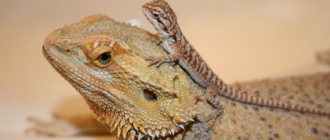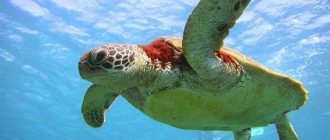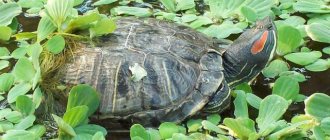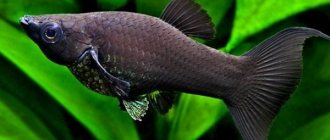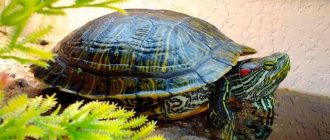Decorative reptiles are loved not only by children, but also by adults. They do not cause discomfort in the form of fur on furniture and carpets, do not require being walked twice a day, and do not run around in a rattling wheel. Many species of small turtles are calm, quiet and hardy, but this does not mean that caring for them can be left to chance.
The closer the living conditions and the more varied the diet, the longer your exotic pet will live. Let's figure out what types there are, how long small turtles can live in captivity, what to feed and how to keep them.
Varieties of dwarf turtles for home keeping
Pets always remain miniature. The average length does not exceed 13 cm. Types of domestic aquarium turtles:
- Musky. Remarkably adapts to keeping in domestic conditions, is resistant to numerous infections, reaches 10-11 cm.
- Bolotnaya. Originally from Europe, reaches 10 cm, sometimes lives up to 50 years. This non-exotic species lives in large numbers in European reservoirs. Sometimes it shows aggression; you need to hold the individuals by the top of their shell.
- Spotted - easily recognized by yellow spots throughout the body. Grows up to 9-10 cm, suitable habitat: 50% water, 50% sand, they need large stones and branches.
- Pondovaya - found in Japan, China, and other eastern countries. It is distinguished by square patterns on the shell, gets sick a lot, does not adapt well to our environment, reaches 11-12 cm.
- Closed species native to America and Africa reach 11-13 cm, depending on the subspecies.
- Flat - grows up to 79 cm, feels great in small aquariums, consumes vegetation, is undemanding in care. Some turtles are mistakenly mistaken for dwarf turtles and reach large sizes.
- The red-eared slider is a popular species among pet reptile enthusiasts. This species is distinguished by its endurance; it is recommended to buy them if a person gets a reptile for the first time; due to the inexperience of the owners, they often die. Pets spend a lot of time under water; the sand should always be illuminated with ultraviolet light.
Red-eared breeds are fast, strong, sometimes show aggression, often attack other reptiles and take food from them.
It is convenient to keep them in an enclosure for people who are allergic to animal fur. When buying pets for children, all responsibility rests with the parents. If you properly care for them, their lifespan is extended to 20-40 years.
Natural habitat conditions include:
- Fresh water.
- Space for heating.
- Plants for the nest.
- Warm.
- Sand or silt at the bottom.
Turtles love to lie on top of each other and bask in the sun.
Red-eared fish are difficult to confuse with other species. A stripe of color runs down the neck from the eyes. The top of the shell is smooth, covered with yellow, black and green stripes. The shell is brightly colored, has a greenish tint, and gradually darkens. Over the years, spots are eliminated, the stripes on the neck fade.
The length of newborn individuals is 2.5 cm, after a year they increase to 5-7 cm. Puberty in males occurs when they grow to 10 cm, and in females - at 12.5 cm. The average dimensions of an individual - 25-30 cm - vary depending on living conditions.
Size does not always accurately indicate age; in domestic conditions they increase more quickly than in nature due to overfeeding and almost ideal conditions.
This breed has well-developed senses, the color spectrum is clearly distinguishable even under water, and suitable places for laying are easily determined. At a distance of 40 m they can detect the movement of other individuals or predators. A keen sense of smell helps to search for food, and the sense of touch allows you to choose tastier foods. Red-eared animals have poor hearing and can only recognize vibrations or muffled sounds. The shell contains nerve fibers, so it is sensitive to touch. The animal hisses, snorts, and squeaks.
Testudo graeca
Mediterranean subspecies have their own colors and different approaches to maintenance. The color can be plain or dark with yellow specks.
There are 5 toes on the front paws. There are spurs on the hind legs. On the back of the thigh there is a bump of horny tissue. They grow up to 35 cm.
Caring for Miniature Turtles
Most of the time they sit in the water. Before purchasing a pet, an aquarium is equipped - it can catch a cold and should not walk around the premises. To maximize lifespan, you must follow the care instructions:
- The aquarium is 3-5 times larger than the size of the pet - it needs more free space.
- Half of the bottom area is filled with water.
- In order for the reptile to alternate living on land and in water, large stones and thick branches are placed at the bottom.
- The ultraviolet lamp helps supply the body with calcium.
- Sand is poured onto the bottom, but changing water in such conditions is difficult.
- Suitable air temperature is 28 degrees.
- Fresh water is poured once a week to prevent the spread of infection, and hands are washed.
- Artificial plants are laid out at the bottom, which pets gradually eat.
- Food container is not installed.
Aquarium volume – 100-150 l. A small terrarium is suitable for land breeds. A certain temperature of water and air is suitable for each species. It is necessary to clarify this information with the seller. Violation of the conditions of detention greatly affects the well-being of the turtle.
Not everyone gets large reptiles, since it is difficult to maintain their normal existence and choose the right soil. An aquarium filter helps purify the water.
Classification:
- External.
- Internal.
The design of the external device is similar to a canister with a pump located outside the aquarium. The housing consists of a pair of compartments with filter material. The tubes are connected to the liquid in which the turtle lives.
The internal ones are not so large, they are equipped with pumps and diffusers, and they remove dirt perfectly. The liquid is filtered by a tube and cartridge, coals and other devices. The product is fixed in different positions.
Required components for an aquarium:
- Priming.
- Artificial pool.
- Backlight.
Reptiles living in hot Asian countries love temperatures of 30-40 degrees, the Libyan breed loves warmth very much. Ultraviolet radiation has a positive effect on the body and allows it to absorb vitamin D.
How is gender determined? Puberty begins at 1 year, you can determine whether it is a female or a male after the size of the reptile reaches 10 cm, after 2-3 years you can say for sure who it is. With good feeding, puberty occurs before the age of 1 year.
Girls are larger than boys, their tail is shorter, and the cloaca is closer to the spine. Males have long and curved claws and a concave plastron.
Sellers often keep pets in poor conditions; after purchase, it is recommended to take them to a veterinarian to check for wounds, diseases and other problems. When replenishing the terrarium, newcomers must be kept in quarantine for about 3 months. Adults and young animals are kept separately, as they can injure each other. Living together is suitable for reptiles that are similar in size and requirements.
Adaptation to a new place takes 2-3 days. During this period, there is mild lethargy or abnormal activity.
People hold them in their hands with caution; if they resist, they often drop them. Bites cause pain, sharp claws can scratch the skin, so they do not cause discomfort when touched
Where to keep a mini turtle
If you are planning to get a mini turtle that will live in water, then for one individual you should take a large, 100-150 liter aquarium. But for a miniature land creature, a small terrarium is suitable. Be sure to find out the temperature conditions for keeping your pet in order to create the most comfortable environment for it, and clarify the specifics of its diet. Compliance with these conditions will guarantee that your turtle will live a long and happy life and will not get sick. About turtle diseases.
Today we talked about the types of miniature turtles that are suitable for home keeping and how to care for these pets. We hope you find this information useful. We are waiting for photos of your miniature turtles. By the way, what type of turtle lives in your home?
Water representatives
Aquatic pet turtles are diverse. These reptiles have membranes on their limbs.
Most species inhabit water bodies where water movement is weak. There are both carnivorous and herbivorous reptile species.
Benefits of keeping baby turtles
Many people dream of having some kind of exotic animal live in their home. It is worth noting that in some apartments you can find pythons, lizards, snakes, etc. Unfortunately, most apartments are not large enough to accommodate a crocodile, for example. Although rare, such an animal can be found.
As for the turtle, this is what is needed. Firstly, this is a completely harmless animal that will not harm anyone, including children, and secondly, a small turtle takes up very little living space. And feeding a small animal is always much easier. In addition, caring for such a pet can be entrusted to a teenager. He will not only become familiar with the living conditions of this animal and its habits, but will also learn to love nature in general, and not just pet turtles.
Pelodiscus sinensis
Chinese Trionix is also called Far Eastern. Its size is up to 20 cm. The shell is soft leather. The nose looks like a proboscis. Three paws. They live in water bodies of Asia. Mobile, aggressive.
The jaws have sharp plates that can injure a person. It can only get into the house through smuggling, since the animal is listed in the Red Book.
The most common breeds of aquarium turtles
Such pets need comfortable conditions, high-quality and regular care, and an equipped tank. However, even such needs do not scare off owners - many decide to have such reptiles. But how can you choose the most suitable pet among the abundance of breeds, because they differ in size, behavior, character? It is worth considering the most popular representatives.
Red-eared (yellow-bellied) turtle
In an aquarium, these animals, whose homeland is North America, can live for a quarter of a century. Reptiles are colored greenish, and behind each of the eyes there are stripes of a bright, scarlet hue. Males have a long, compacted tail, elongated claws on their forelimbs, and their dorsal shield is smaller than that of females. The plastorn is an abdominal shield, of a concave type, while in females it is straight.
The red-eared turtle is an aquatic species, so it needs a tank of water. Young individuals prefer animal food - they eat fish, shellfish, and insects. As they grow older, their gastronomic preferences change, and reptiles switch to a plant-based diet.
It is recommended to feed aquarium pets variedly, giving them foods containing plant and animal proteins. To keep the tank clean much longer, it is advisable to give your pet food outside of it. Naturally, the meal will require more time and attention from the owner.
For a comfortable life for an exotic pet, you need to purchase an aquarium with a volume of at least 150 liters. Only in a spacious tank will the red-bellied turtle feel good. A quarter of the container should be occupied by a sloping bank; it should be installed in such a way that the earthen embankment does not end up in the water.
Water should be prepared in advance: cleaned, settled, temperature 20°-22°C. It is replaced every week; filtering is not necessary, but acceptable. It is advisable to equip the tank with an additional source of ultraviolet rays and illumination.
In the summer, when the aquarium is constantly illuminated by sunlight, red-eared turtles begin to reproduce. It is recommended to place duckweed and filamentous algae in the tank.
Emys orbicularis (European swamp)
The reptile has a small carapace, the length of which is approximately 20 cm. But the limbs have large nail plates and webbed feet. Almost the entire body and shell are covered with small spots, lighter than the main color.
They choose reservoirs with fresh water and a bottom covered with a layer of silt as their habitat. They hunt mainly in the daytime, feeding on various small animals. Among domestic turtles, the marsh turtle is distinguished by its decent size - the weight of individuals reaches 2 kg.
The reptile has an elongated tail, which helps it regulate its trajectory while moving in the water. In adult turtles, the shell becomes dark - brownish, brownish or deep olive, with yellow specks on the main background. Eyes – yellow or orange.
These reptiles are capable of staying under water for a long time, being excellent swimmers. Almost any live food can be used as food - from larvae to small crustaceans and fish. You can give food yourself or place it on a special hanging feeder. Swamp turtles swallow food only while in the water. You cannot include minced meat in your pet's diet.
European turtles are kept in spacious 150-200-liter aquariums, in which equipment is installed like “artificial islands” that form a coastline. Medium and large stones are used as soil.
Water can be filtered. Suitable water temperature varies from 25° to 28°C, the depth should be no more than 20 cm. In addition, the tank must be equipped with additional devices:
- heating lamps that do not provide light;
- UV lamp;
- low-pressure mercury gas-discharge lighting device (fluorescent);
- thermometer;
- aquafilter;
- an aquarium heater with which you can regulate the water temperature.
If a pet is provided with proper care, its life expectancy can be about three decades. In addition to these popular aquarium inhabitants, there are several breeds of smaller turtles that are kept as pets.
Testudo hermanni
Light brown shell with dark pattern. Balkanskaya grows up to 20 cm.
Externally, the turtle looks like a Mediterranean “tribesman”. The color changes over the years, eventually becoming yellowish-gray.
Tail with a horny tip. Loves peas, beans, clover, fruits. You can diversify the menu with slugs and snails. You will find out what to feed pet turtles in the next article.
What to feed a turtle
Choosing a diet for a red-eared slider is not at all difficult. Since she is a predator, she will eat raw meat, fish, even with bones, with great pleasure. The only thing the animal needs to limit is fatty fish. The turtle also eats bloodworms and granulated food with great pleasure. However, you should not feed the animal with only one type of food; the food must be varied and complete, otherwise the reptile will develop rickets and deformation of the shell occurs. This occurs due to a lack of vitamin D. Therefore, it is necessary to follow certain feeding rules. Young reptiles are fed mainly food of animal origin, gradually increasing plant nutrition. From birth to two years, the animal is fed once a day. After a day.
Testudo kleinmanni
"Egyptian" has a sandy colored shell with black spots. It reaches 12 cm. Males are larger than females. Picky about content. They get sick easily.
Preference is given to herbs of the wormwood genus. Be sure to add calcium and vitamin D3. Gender can only be determined at age 15.
Types of small turtles for home keeping
Small turtles are those that, even as adults, do not reach a length of more than 12 centimeters. If a turtle has a body length of more than 15 centimeters, it is already classified as a medium-sized pet, and it needs a special move. All other turtles (up to 15 centimeters) belong to the mini category. However, you must be aware that if you buy a small turtle, then in childhood it may only be a few centimeters long, while over time it will definitely grow a little. This is a natural process and you must be prepared for it - perhaps in a couple of months you will have to buy a larger aquarium to comfortably keep your aquatic pet.
Flathead or flat-bodied turtles
The body length of an adult can reach 8-9 centimeters, and the weight can be 100-200 grams. A small aquarium will do to keep these little ones, and the fact that these turtles feed on succulent plants, which contain a lot of moisture, makes caring for them a simple task, even a child can do. This is one of the unpretentious types of mini turtles, which can be recommended even to novice turtle keepers. Read more about what turtles eat.
Locking turtles
In nature, these creatures live in Africa, Mexico and America. There are 4 known subspecies of these turtles, but the Sonoran and yellow turtles are more popular. They reach sizes of up to 13 centimeters in adulthood. But striped and mud turtles grow a little smaller - up to 11 centimeters.
Musk turtles
Excellent candidates for the role of a pet. As adults, they rarely grow longer than 15 centimeters. Moreover, 4 types of them are also known. Representatives of each species differ in their color and size. Sternotherus depressus is considered to be the smallest - the size of an adult does not exceed 11 centimeters.
Spotted turtles
These turtles cannot be classified as completely aquatic creatures, as they do not mind getting out and being on land for a while. So, they are half aquatic, half land creatures, and for them to live comfortably in your home, you will need to take care of an aquarium terrarium that could provide them with a habitat convenient for them, providing both a piece of land and an artificial pond. Fortunately, the size of an adult turtle is no more than 13 centimeters, so there is no need to equip a very large house for them.
Three-keeled Chinese turtles
On average, the body length of an adult does not exceed 13 centimeters. Attractive appearance, unpretentiousness in terms of maintenance requirements, calm character - all this turns these creatures into favorites of turtle keepers, and especially those who do not have much experience in keeping turtles.
Hibernation and reproduction
The statement that turtles must hibernate every year is not always true. At home, this is not even advisable. Only a specialist can prepare an animal for hibernation and ensure the correctness of such rest, otherwise it will sleep forever.
If your pet stays in a corner of the terrarium for a long time and tries to burrow into the ground, it is probably getting ready for sleep. To prevent this from happening, it is necessary to fatten it and carefully read specialized literature on ensuring turtle hibernation so that the animal remains alive and healthy. With good care and proper nutrition, pets can live 15-30 years.
If you are serious about running a “turtle” business, it is better to start with 3 individuals of the same age and size - 2 females and 1 male. More than two men compete for territory and ladies. It is better to keep aquatic reptiles separately, allowing them to be together only for mating.
When buying a pet, you need to pay attention to the behavior - this will tell you whether the individual is healthy. The shell should be without cracks, there should be no spots on the skin, the mucous membrane of the mouth should be pale pink in color, saliva should not be sticky, breathing should be calm, no discharge from the mouth or nose.
Most turtles carry salmonella, as well as other bacteria and viruses that can be dangerous (especially to children). Therefore, you need to ensure that your child washes their hands thoroughly when coming into contact with a turtle.
Where to keep a mini turtle
For the normal existence and development of an aquatic miniature turtle, you will need a 100-150 liter aquarium. As for the land species, a small terrarium is enough. At the same time, you need to know about the minimum and maximum temperatures so that your pet feels comfortable. It’s also a good idea to know about his diet. You need to know that all pet turtles are representatives of hot countries that need suitable temperature and humidity. Only with this approach will your pet be always healthy and delight others with its activity.
If these conditions are violated, then you need to be prepared for very unpleasant surprises. You should know that it is better to prevent negative consequences than to get rid of them later. The first thing that can happen is that the turtle gets sick, and treating such a baby, especially on your own, is very difficult and you can’t do it without a specialist herpetologist. And this, after all, is not only a loss of precious time, but also a waste of money. At the same time, we should not forget about the psychological aspect.

